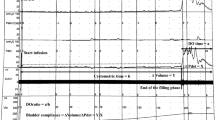Abstract
Purpose
To investigate whether ultrasonographic bladder wall thickness (BWT) correlates with urodynamic parameters in patients with spinal cord injury (SCI).
Methods
Two hundred and seventy-two patients with SCI were enrolled in the study. All of the patients underwent bladder ultrasonography and urodynamic study. The anterior bladder wall was measured and compared to urodynamic data.
Results
The mean age of the patients was 37.4 years. The mean BWT was 3.9 mm. BWT was significantly higher in the patients with neurogenic detrusor overactivity associated with detrusor sphincter dyssynergia (NDO/DSD) compared to those without sphincter dyssynergia (4.2 vs. 3.6 mm, respectively, p < 0.001) and in those with compliance <20 ml/cm H2O. Nevertheless, ROC curve analysis [ROC = 0.624, 95 % CI (0.530, 0.718), p = 0.011] showed that no meaningful BWT measurement cutoff could be made to predict an elevated detrusor pressure in the storage phase.
Conclusions
Increased BWT was present in patients with low bladder compliance and NDO/DSD. No BWT cutoff value to predict an elevated detrusor pressure was found. Therefore, the measurement of BWT has no clinical role in patients with SCI and cannot replace urodynamic evaluation.

Similar content being viewed by others
References
Kaplan SA, Chancellor MB, Blaivas JG (1991) Bladder and sphincter behavior in patients with spinal cord lesions. J Urol 146(1):113–117
Gerridzen RG, Thijssen AM, Dehoux E (1992) Risk factors for upper tract deterioration in chronic spinal cord injury patients. J Urol 147(2):416–418
McGuire EJ, Woodside JR, Borden TA, Weiss RM (1981) Prognostic value of urodynamic testing in myelodysplastic patients. J Urol 126(2):205–209
Weld KJ, Graney MJ, Dmochowski RR (2000) Differences in bladder compliance with time and associations of bladder management with compliance in spinal cord injured patients. J Urol 163(4):1228–1233
Abrams P, Larsson G, Chapple C, Wein AJ (1999) Factors involved in the success of antimuscarinic treatment. BJU Int 83(Suppl 2):42–47
Hakenberg OW, Linne C, Manseck A, Wirth MP (2000) Bladder wall thickness in normal adults and men with mild lower urinary tract symptoms and benign prostatic enlargement. Neurourol Urodyn 19(5):585–593
Blatt AH, Titus J, Chan L (2008) Ultrasound measurement of bladder wall thickness in the assessment of voiding dysfunction. J Urol 179(6):2275–2278
Tanaka H, Matsuda M, Moriya K, Mitsui T, Kitta T, Nonomura K (2008) Ultrasonographic measurement of bladder wall thickness as a risk factor for upper urinary tract deterioration in children with myelodysplasia. J Urol 180(1):312–316
Ukimura O, Kojima M, Inui E, Ochiai A, Naya Y, Kawauchi A et al (1998) Noninvasive evaluation of bladder compliance in children using ultrasound estimated bladder weight. J Urol 160(4):1459–1462
Pannek J, Bartel P, Gocking K, Frotzler A (2013) Clinical usefulness of ultrasound assessment of detrusor wall thickness in patients with neurogenic lower urinary tract dysfunction due to spinal cord injury: urodynamics made easy? World J Urol 31(3):659–664
Abrams P, Cardozo L, Fall M, Griffiths D, Rosier P, Ulmsten U et al (2002) The standardisation of terminology of lower urinary tract function: report from the standardisation sub-committee of the International Continence Society. Neurourol Urodyn 21(2):167–178
Schafer W, Abrams P, Liao L, Mattiasson A, Pesce F, Spangberg A et al (2002) Good urodynamic practices: uroflowmetry, filling cystometry, and pressure-flow studies. Neurourol Urodyn 21(3):261–274
Watanabe T, Rivas DA, Chancellor MB (1996) Urodynamics of spinal cord injury. Urol Clin N Am 23(3):459–473
Levin RM, Haugaard N, O’Connor L, Buttyan R, Das A, Dixon JS et al (2000) Obstructive response of human bladder to BPH vs. rabbit bladder response to partial outlet obstruction: a direct comparison. Neurourol Urodyn 19(5):609–629
Gilpin SA, Gosling JA, Barnard RJ (1985) Morphological and morphometric studies of the human obstructed, trabeculated urinary bladder. Br J Urol 57(5):525–529
Elbadawi A, Yalla SV, Resnick NM (1993) Structural basis of geriatric voiding dysfunction. IV. Bladder outlet obstruction. J Urol 150(5 Pt 2):1681–1695
Manieri C, Carter SS, Romano G, Trucchi A, Valenti M, Tubaro A (1998) The diagnosis of bladder outlet obstruction in men by ultrasound measurement of bladder wall thickness. J Urol 159(3):761–765
Naya Y, Kojima M, Honjyo H, Ochiai A, Ukimura O, Watanabe H (1998) Intraobserver and interobserver variance in the measurement of ultrasound-estimated bladder weight. Ultrasound Med Biol 24(5):771–773
Oelke M, Hofner K, Jonas U, Ubbink D, de la Rosette J, Wijkstra H (2006) Ultrasound measurement of detrusor wall thickness in healthy adults. Neurourol Urodyn 25(4):308–317
Bright E, Oelke M, Tubaro A, Abrams P (2010) Ultrasound estimated bladder weight and measurement of bladder wall thickness—useful noninvasive methods for assessing the lower urinary tract? J Urol 184(5):1847–1854
Acknowledgments
We are grateful to the nursing team that supported this work. We are also indebted to the statistician Marcelo Anzanello for his valuable statistical analysis.
Conflict of interest
The authors declare no conflict of interest.
Ethical standard
All patients studies have been approved by the appropriate ethics committee and have therefore been performed in accordance with the ethical standards laid down in the 1964 Declaration of Helsinki and its later amendments. All persons gave their informed consent prior to their inclusion in the study.
Author information
Authors and Affiliations
Corresponding author
Rights and permissions
About this article
Cite this article
Silva, J.A.F., Gonsalves, M.C.D., de Melo, R.T. et al. Association between the bladder wall thickness and urodynamic findings in patients with spinal cord injury. World J Urol 33, 131–135 (2015). https://doi.org/10.1007/s00345-014-1265-x
Received:
Accepted:
Published:
Issue Date:
DOI: https://doi.org/10.1007/s00345-014-1265-x




